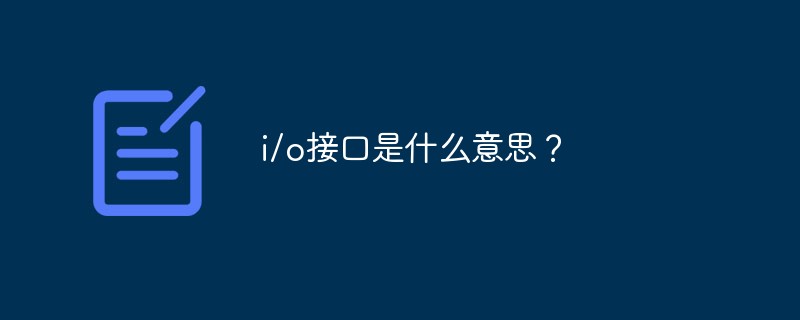
The full name of the i/o interface is the Input/Ouput interface, which is the input/output interface. It is a connection circuit for exchanging information between the CPU and external devices. They are connected to the CPU through the bus; the I/O interface can be divided into buses. There are two types of interfaces and communication interfaces.

The computer input and output interface is a connection circuit for exchanging information between the CPU and external devices. They are connected to the CPU through a bus, referred to as the I/O interface (Input/ Output interface). I/O interfaces are divided into two categories: bus interface and communication interface.
The computer I/O interface is used for data, information exchange and control between external devices or user circuits and the CPU. When used, the microcomputer bus should be used to connect the external devices and user circuits. At this time, it is necessary Use the microcomputer bus interface; use the communication interface when the microcomputer system directly communicates digitally with other systems.
The so-called bus interface is a bus socket that provides the microcomputer bus to the user through a circuit socket for inserting various function cards. Each pin of the socket is connected to the corresponding signal line of the microcomputer bus. The user only needs to make the plug-in board for the external device or user circuit according to the order of the bus arrangement, so that the external device or user circuit can be connected to the system bus, so that the external device can be connected to the system bus. Or the user circuit is integrated with the microcomputer system.
Commonly used bus interfaces include: AT bus interface, PCI bus interface, IDE bus interface, etc.
AT bus interface is mostly used to connect external devices in 16-bit microcomputer systems, such as 16-bit sound cards, low-speed display adapters, 16-bit data acquisition cards, and network cards.
The PCI bus interface is used to connect external devices in 32-bit microcomputer systems, such as 3D display cards, high-speed data acquisition cards, etc.
The IDE bus interface is mainly used to connect various disks and optical disk drives, which can improve the data exchange speed and capability of the system.
Communication interface refers to the interface circuit for direct digital communication between a microcomputer system and other systems. It is usually divided into two types: serial communication interface and parallel communication interface, namely serial port and parallel port.
The serial port is used to connect low-speed external devices such as MODEM to microcomputers. The method of transmitting information is one by one. The standard for the serial port is the EIA (Electronics Industry Association) RS-232C standard. There are two types of serial port connectors: D-type 9-pin socket and D-type 25-pin socket, which are located on the back panel of the computer mainframe. The mouse is connected to this serial port.
Parallel interfaces are mostly used to connect high-speed external devices such as printers. The way to transmit information is by byte, that is, 8 binary bits are transmitted simultaneously. The parallel port used by the PC is the standard parallel port Centronics. Printers generally use a parallel port to communicate with the computer, and the parallel port is also located on the rear panel of the computer host box.
I/O interfaces are generally in the form of circuit plug-in cards, so they are usually called adapter cards, such as floppy disk drive adapter cards, hard drive adapter cards (IDE interface), and parallel printer adapters card (parallel port), serial communication adapter card (serial port), including display interface, audio interface, network card interface (RJ45 interface), telephone interface used by modem (RJ11 interface), etc.
In microcomputer systems above 386, these adapter cards are usually built on a circuit board and are called composite adapter cards or multi-function adapter cards, referred to as multi-function cards.
The above is the detailed content of What does i/o interface mean?. For more information, please follow other related articles on the PHP Chinese website!
 How to use mysql workbench
How to use mysql workbench What does the metaverse concept mean?
What does the metaverse concept mean? memset function usage
memset function usage GAMMAINV function usage
GAMMAINV function usage A complete list of CAD shortcut key commands
A complete list of CAD shortcut key commands Why can't my mobile phone make calls but not surf the Internet?
Why can't my mobile phone make calls but not surf the Internet? User Account Control Cancellation Method
User Account Control Cancellation Method What to do if the CPU usage is too high
What to do if the CPU usage is too high